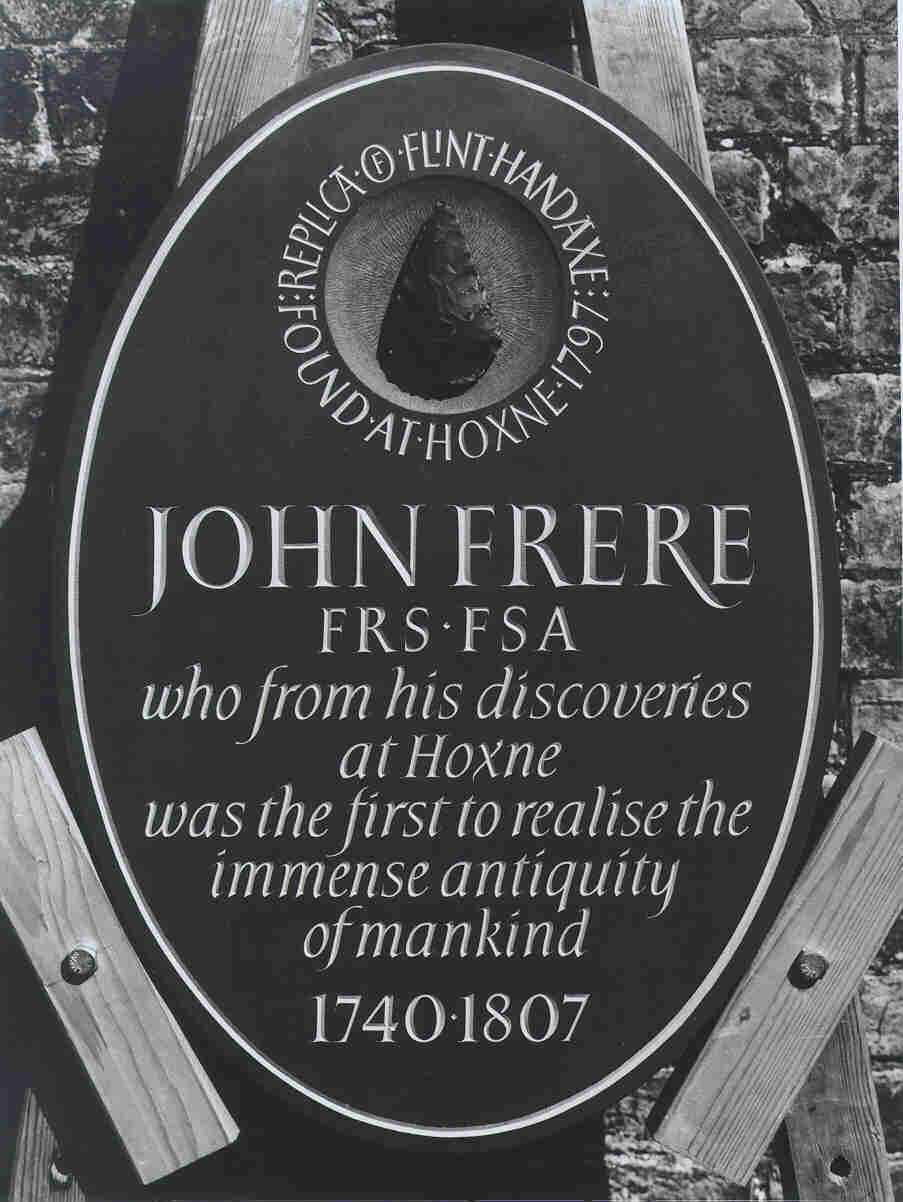
JOHN FRERE


Plaque installed during August of 1999 at Finningham, Suffolk, England, near the now famous site of Hoxne in Suffolk. (photo courtesy of John Frere Scott, one of the individuals involved in erecting the Plaque). The Plaque was sculpted by the Cardozo-Kinderslay Workshops at Cambridge founded by the late David Kindersley. The Finningham Church is the resting place of many early Freres. There is much there of interest to family members.
John Frere was the father of John Hookham Frere, who was a British Diplomat during the Peninsular Wars and Writer. John Hookham Frere retired to Villa Frere in Malta which still exists. Sir Bartle Henry Frere was John Hookham's nephew. John Frere was a Memeber of Parliament (MP), as well as FRS. John Frere also had a son George of "Lincoln's Inn" who was one of the founding partners of the lawyers Frere Cholmeley and a founder of the Law Society. More information can be found on these individuals at "Additional Information on Freres". As an added footnote there were a few Freers who served as Officers under the Duke of Wellington in the Peninsular Wars, including Colonel Arthur William Wellington Freer.
The brief, but defining, article below written by Antiquarian John Frere in 1790 set the stage for Paleolithic Archaeology as we know it today. It challenged Archbishop James Ussher's Creationist doctrine made in the early 1600s that pinpointed creation as beginning at 9:00 PM on October 23rd in 4004 B.C. Among the tools first identified by Frere was the Acheulian HandAxe which has become a basic “Horizon Marker” of the Lower Paleolithic cultures studied by archaeologist today. (Stan Freer, Ph.D. - Archaeologist)
(“The Beginning of Paleolithic Archaeology” John Frere from Man’s Discovery of his Past:
Literary Landmarks in Archaeology edited by Robert F. Heizer, PrenticeHall, Inc., 1962, pp. 70-71)
printed as "Account of Flint Weapons Discovered at Hoxne in Suffolk,"
Archaeologia, 1800, vol. 13, pp. 204-205.
John Frere's account of finding in 1790 Acheulean handaxes associated with the large bones of unknown animals (actually elephants) is the first clear presentation of the association in an open site of manmade tools and extinct animals. This account was ignored until J. Flower called attention to it sixty years later. Prestwich (see his account further on in this chapter) and Lyell (1863:166169) visited the Hoxne pit and described the geology, and interest in the locality is still active (West, 1956).
The Beginning of Paleolithic Archaeology
John Frere
LETTER TO THE REV. JOHN BRAND, SECRETARY, READ JUNE 22, 1797
Sir:
I take the liberty to request you to lay before the Society some flints found in the parish of Hoxne, in the county of Suflolk, which, if not particularly objects of curiosity in themselves, must, I think, be considered in that light from the situation in which they were found.
They are, I think, evident weapons of war, fabricated and used by a people who had not the use of metals. They lay in great numbers at the depth of about twelve feet, in a stratified soil, which was dug into for the purpose of raising clay for bricks.
The strata are as follows:
1. Vegetable earth l l/2 feet.
2. Argill 7 l/2 feet.
3. Sand mixed with shells and other marine substances 1 foot.
4. A gravelly soil, in which the flints are found, generally at the rate of five or six in a square yard, 2 feet.
In the same stratum are frequently found small fragments of wood, very perfect when first dug up, but which soon decompose on being exposed to the air; and in the stratum of sand (No. 3), were found some extraordinary bones, particularly a jawbone of enormous size, of some unknown animal, with the teeth remaining in it. I was very eager to obtain a sight of this; and finding it had been carried to a neighboring gentleman, I inquired of him, but learned that he had presented it, together with a huge thighbone, found in the same place, to Sir Ashton Lever, and it therefore is probably now in Parkinson's Museum.
The situation in which these weapons were found may tempt us to refer them to a very remote period indeed; even beyond that of the present world; but, whatever our conjectures on that head may be, it will be difficult to account for the stratum in which they lie being covered with another stratum, which, on that supposition, may be conjectured to have been once the bottom, or at least the shore, of the sea. The manner in which they lie would lead to the persuasion that it was a place of their manufacture and not of their accidental deposit; and the numbers of them were so great that the man who carried on the brickwork told me that before he was aware of their being objects of curiosity, he had emptied baskets full of them into the ruts of the adjoining road. It may be conjectured that the different strata were formed by inundations happening at distant periods, and bringing down in succession the different materials of which they consist; to which I can only say that the ground in question does not lie at the foot of any higher ground, but does itself overhang a track of boggy earth, which extendsunder the fourth stratum; so that it should rather seem that torrents had washed away the incumbent strata and left the bogearth bare, than that the bogearth was covered by them, especially as the strata appear to be disposedhorizontally, and present their edges to the abrupt termination of the high ground.
If you think the above worthy the notice of the Society you will please to lay it before them.
I am, Sir,
with great respect,
Your faithful humble Servant,
John Frere

TO TRIBUTE TO ANTIQUARIAN JOHN FRERE
TO PEDIGREE OF JOHN OF SWEFFLING BY HORACE AND ARTHUR HOWARD FRERE